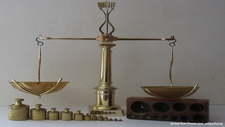Using a Balance

TEKS Objective
The student is expected to collect, record, and analyze information using tools, including calculators, microscopes, cameras, computers, hand lenses, metric rulers, Celsius thermometers, mirrors, spring scales, pan balances, triple beam balances, graduated cylinders, beakers, hot plates, meter sticks, compasses, magnets, collecting nets, and notebooks; timing devices, including clocks and stopwatches; and materials to support observation of habitats of organisms such as terrariums and aquariums.
Essential Understanding
The student knows how to use a variety of tools, materials, equipment, and models to conduct science inquiry.
Science Background
Understanding the Basics of Balancing and Measuring Techniques: Gary Grim and Bruce Mitchell, Balance Technology Inc. (PDF) - This article explains, in detail, the fundamental scientific principles of balancing.
Balance Theory: Ohaus (website) - This teacher-focused section of the Ohaus website describes how mechanical balances work and explains the physics involved in the use of triple beam balances.
Signature Lesson
Mass: Ohio State University (PDF) - This lesson focuses on the use of balances. Students collect, record, compare and analyze the mass of several objects using a triple beam balance. They learn that mass is a physical property by which objects can been classified.
- Supporting Lessons
- Extensions
- Assessment Ideas
- Literature Connections
- Related
TEKS - Additional Resources
Supporting Lessons
Setting the Standard: Utah Education Network (website) - Students learn about measuring and weighing objects; describe relationships among units of measurement for length, capacity and weight; and use tools to measure angles.
Setting the Standard
Utah Education Network (website), www.uen.org
Elaboration Lessons and Extensions
Measuring: Oklahoma State University (PDF) - Students explore the relationship between weight and mass, become familiar with dimensions and volume, and practice using metric measures.
Measuring
Oklahoma State University (PDF), www.gk-12.osu.edu
Assessment Ideas
Ask students to weigh a small dry sponge, and then soak the sponge to capacity with water and weigh it again. Have them follow up by writing a math problem that expresses the weight of water held by the sponge.
Literature Connections
Measuring Penny. Leedy, Loreen (ISBN-13: 978-0805065725)
Weighing and Measuring. Jennings, Terry (ISBN-13: 978-0817239633)
Balances. Richardson, Adele (ISBN-13: 978-0736849609)
Additional Resources
Metric Mania: The Science Spot (website) - This series of metric lessons includes labs on length, mass, volume, density, temperature and conversions, enabling students to use metric tools and equipment and learn how to use the metric system of measurements.
Metric Mania
The Science Spot (website), www.sciencespot.net
TEKS Navigation
Grade 4
Need Assistance?
If you need help or have a question please use the links below to help resolve your problem.

Comments